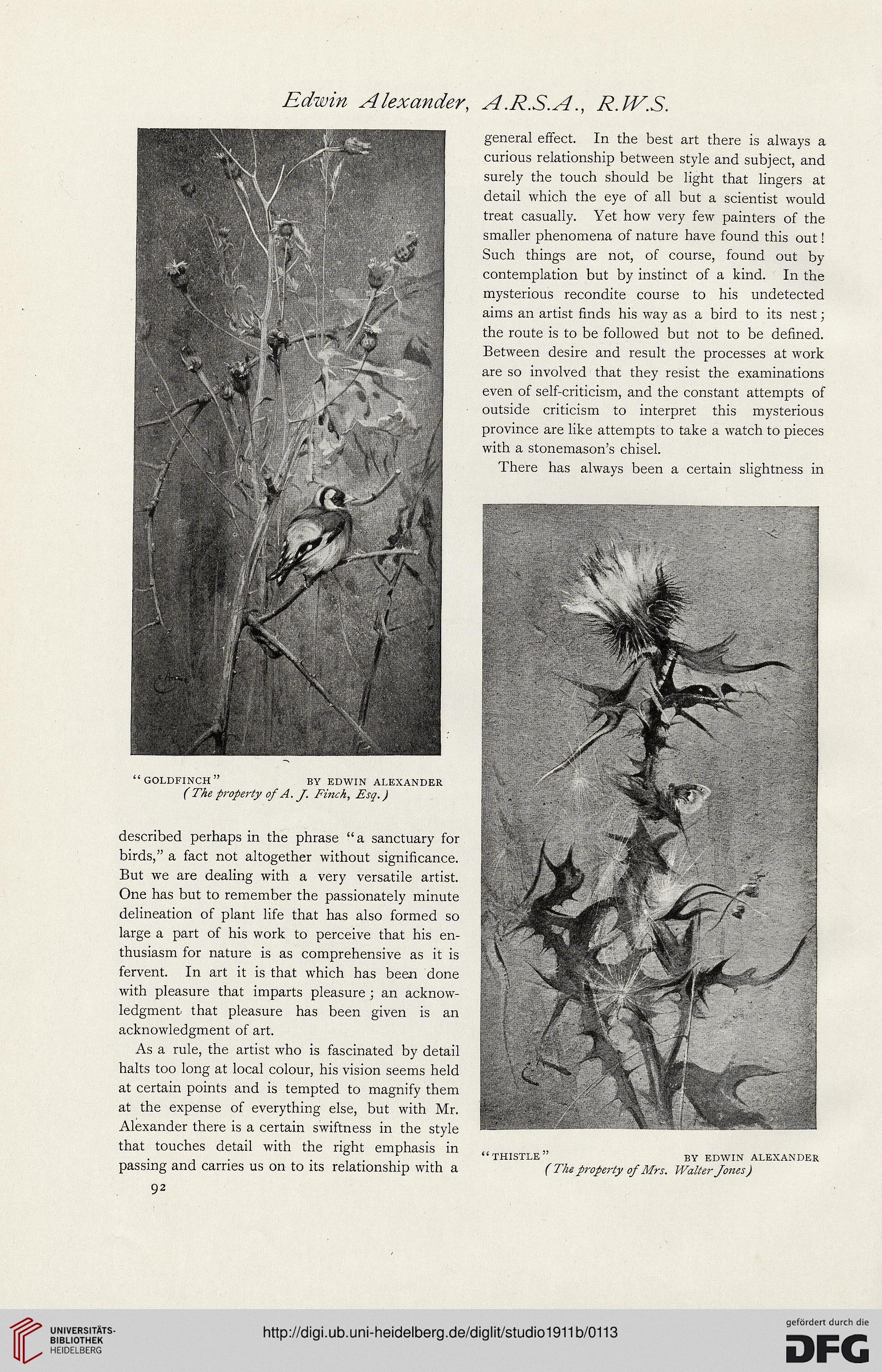Edwin Alexander, A.R.S.A., R.IV.S.
"GOLDFINCH" BY EDWIN ALEXANDER
( The property of A. J. Finch, Esq.)
described perhaps in the phrase " a sanctuary for
birds," a fact not altogether without significance.
But we are dealing with a very versatile artist.
One has but to remember the passionately minute
delineation of plant life that has also formed so
large a part of his work to perceive that his en-
thusiasm for nature is as comprehensive as it is
fervent. In art it is that which has been done
with pleasure that imparts pleasure ; an acknow-
ledgment that pleasure has been given is an
acknowledgment of art.
As a rule, the artist who is fascinated by detail
halts too long at local colour, his vision seems held
at certain points and is tempted to magnify them
at the expense of everything else, but with Mr.
Alexander there is a certain swiftness in the style
that touches detail with the right emphasis in
passing and carries us on to its relationship with a
92
general effect. In the best art there is always a
curious relationship between style and subject, and
surely the touch should be light that lingers at
detail which the eye of all but a scientist would
treat casually. Yet how very few painters of the
smaller phenomena of nature have found this out!
Such things are not, of course, found out by-
contemplation but by instinct of a kind. In the
mysterious recondite course to his undetected
aims an artist finds his way as a bird to its nest;
the route is to be followed but not to be defined.
Between desire and result the processes at work
are so involved that they resist the examinations
even of self-criticism, and the constant attempts of
outside criticism to interpret this mysterious
province are like attempts to take a watch to pieces
with a stonemason's chisel.
There has always been a certain slightness in
"THISTLE" BY EDWIN ALEXANDER
( The property of Mrs. Walter Jones)
"GOLDFINCH" BY EDWIN ALEXANDER
( The property of A. J. Finch, Esq.)
described perhaps in the phrase " a sanctuary for
birds," a fact not altogether without significance.
But we are dealing with a very versatile artist.
One has but to remember the passionately minute
delineation of plant life that has also formed so
large a part of his work to perceive that his en-
thusiasm for nature is as comprehensive as it is
fervent. In art it is that which has been done
with pleasure that imparts pleasure ; an acknow-
ledgment that pleasure has been given is an
acknowledgment of art.
As a rule, the artist who is fascinated by detail
halts too long at local colour, his vision seems held
at certain points and is tempted to magnify them
at the expense of everything else, but with Mr.
Alexander there is a certain swiftness in the style
that touches detail with the right emphasis in
passing and carries us on to its relationship with a
92
general effect. In the best art there is always a
curious relationship between style and subject, and
surely the touch should be light that lingers at
detail which the eye of all but a scientist would
treat casually. Yet how very few painters of the
smaller phenomena of nature have found this out!
Such things are not, of course, found out by-
contemplation but by instinct of a kind. In the
mysterious recondite course to his undetected
aims an artist finds his way as a bird to its nest;
the route is to be followed but not to be defined.
Between desire and result the processes at work
are so involved that they resist the examinations
even of self-criticism, and the constant attempts of
outside criticism to interpret this mysterious
province are like attempts to take a watch to pieces
with a stonemason's chisel.
There has always been a certain slightness in
"THISTLE" BY EDWIN ALEXANDER
( The property of Mrs. Walter Jones)




